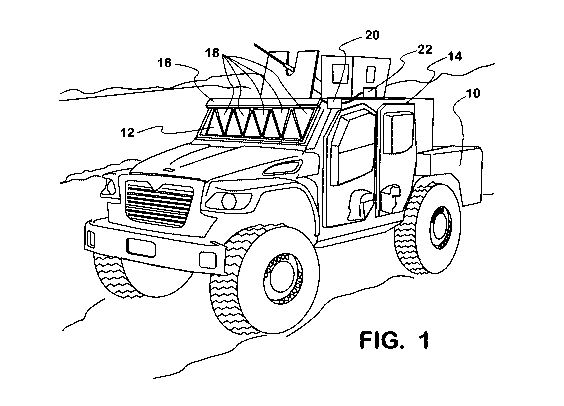Some of the information on this Web page has been provided by external sources. The Government of Canada is not responsible for the accuracy, reliability or currency of the information supplied by external sources. Users wishing to rely upon this information should consult directly with the source of the information. Content provided by external sources is not subject to official languages, privacy and accessibility requirements.
Any discrepancies in the text and image of the Claims and Abstract are due to differing posting times. Text of the Claims and Abstract are posted:
| (12) Patent Application: | (11) CA 2780262 |
|---|---|
| (54) English Title: | VEHICLE WITH PARTICULATE RESISTANT WINDSHIELD |
| (54) French Title: | VEHICULE POURVU D'UN PARE-BRISE RESISTANT AUX PARTICULES |
| Status: | Deemed Abandoned and Beyond the Period of Reinstatement - Pending Response to Notice of Disregarded Communication |
| (51) International Patent Classification (IPC): |
|
|---|---|
| (72) Inventors : |
|
| (73) Owners : |
|
| (71) Applicants : |
|
| (74) Agent: | FINLAYSON & SINGLEHURST |
| (74) Associate agent: | |
| (45) Issued: | |
| (86) PCT Filing Date: | 2009-11-24 |
| (87) Open to Public Inspection: | 2011-06-03 |
| Availability of licence: | N/A |
| Dedicated to the Public: | N/A |
| (25) Language of filing: | English |
| Patent Cooperation Treaty (PCT): | Yes |
|---|---|
| (86) PCT Filing Number: | PCT/US2009/065719 |
| (87) International Publication Number: | US2009065719 |
| (85) National Entry: | 2012-05-07 |
| (30) Application Priority Data: | None |
|---|
A vehicle (10) having a particulate resistant windshield (12) comprises a windshield, an ionizer (16), and a controller (20). The windshield is disposed in a cab portion (14) of a vehicle. The windshield has a periphery. The ionizer has at least one electrode (18) disposed adjacent the periphery of the windshield. The controller is in electrical communication with the ionizer. The controller generates a signal transmitted to the ionizer to control generation of ions by the ionizer. The ions generated by the ionizer are directed towards at least a portion of the windshield.
La présente invention concerne un véhicule (10) présentant un pare-brise résistant aux particules (12) comprenant un pare-brise, un ioniseur (16) et un dispositif de commande (20). Le pare-brise est disposé dans une partie cabine (14) d'un véhicule. Le pare-brise présente une périphérie. L'ioniseur présente au moins une électrode (18) disposée de manière adjacente à la périphérie du pare-brise. Le dispositif de commande est en communication électrique avec l'ioniseur. Le dispositif de commande génère un signal transmis à l'ioniseur pour commander la génération d'ions par l'ioniseur. Les ions générés par l'ioniseur sont dirigés vers une ou des parties du pare-brise.
Note: Claims are shown in the official language in which they were submitted.
Note: Descriptions are shown in the official language in which they were submitted.

2024-08-01:As part of the Next Generation Patents (NGP) transition, the Canadian Patents Database (CPD) now contains a more detailed Event History, which replicates the Event Log of our new back-office solution.
Please note that "Inactive:" events refers to events no longer in use in our new back-office solution.
For a clearer understanding of the status of the application/patent presented on this page, the site Disclaimer , as well as the definitions for Patent , Event History , Maintenance Fee and Payment History should be consulted.
| Description | Date |
|---|---|
| Application Not Reinstated by Deadline | 2015-11-24 |
| Time Limit for Reversal Expired | 2015-11-24 |
| Inactive: Abandon-RFE+Late fee unpaid-Correspondence sent | 2014-11-24 |
| Deemed Abandoned - Failure to Respond to Maintenance Fee Notice | 2014-11-24 |
| Inactive: First IPC assigned | 2013-01-31 |
| Inactive: Cover page published | 2012-07-25 |
| Inactive: Notice - National entry - No RFE | 2012-07-05 |
| Inactive: IPC assigned | 2012-07-04 |
| Inactive: IPC assigned | 2012-07-04 |
| Inactive: First IPC assigned | 2012-07-04 |
| Application Received - PCT | 2012-07-04 |
| National Entry Requirements Determined Compliant | 2012-05-07 |
| Application Published (Open to Public Inspection) | 2011-06-03 |
| Abandonment Date | Reason | Reinstatement Date |
|---|---|---|
| 2014-11-24 |
The last payment was received on 2013-09-23
Note : If the full payment has not been received on or before the date indicated, a further fee may be required which may be one of the following
Patent fees are adjusted on the 1st of January every year. The amounts above are the current amounts if received by December 31 of the current year.
Please refer to the CIPO
Patent Fees
web page to see all current fee amounts.
| Fee Type | Anniversary Year | Due Date | Paid Date |
|---|---|---|---|
| Basic national fee - standard | 2012-05-07 | ||
| MF (application, 2nd anniv.) - standard | 02 | 2011-11-24 | 2012-05-07 |
| MF (application, 3rd anniv.) - standard | 03 | 2012-11-26 | 2012-09-24 |
| MF (application, 4th anniv.) - standard | 04 | 2013-11-25 | 2013-09-23 |
Note: Records showing the ownership history in alphabetical order.
| Current Owners on Record |
|---|
| INTERNATIONAL TRUCK INTELLECTUAL PROPERTY COMPANY, LLC |
| Past Owners on Record |
|---|
| DAVID G. STRAND |